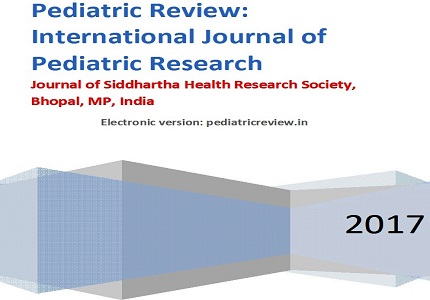Feeding practices and problems in breastfeeding in the first postnatal week in late preterm infants
Abstract
Background and objective: Breastfeeding problems exist despite advice and counseling. Problems are more in late preterm babies compared to term. Problems in feeding start in early postnatal life which continues later. The aim of the study was done to know the feeding practices and problems in breastfeeding in the first postnatal week in late preterm babies.
Methods: This was a cross sectional study. Total 77 late preterm babies were included in the study.
Results: Only 28.57% initiated breast feeding within one hour of birth. Initiation of breast feeding within one hour after birth and exclusive breastfeeding in first postnatal week was seen better in late preterm babies born by vaginal route, born to mulitparous and male sex. Prelacteal feeds were given in 16.88%. Bottle feeding was seen in 62.75% in mothers who did not follow exclusive breast feeding in the first postnatal week. Most common causes for non-exclusive breast feeding in first postnatal week was insufficient milk (72.55%), baby not able to suck (60.78%), elders advice (54.9%) and wound pain (27.45%). Problems with breast feeding are more common in late preterm infants born by Cesarean Section.
Conclusion: Despite counseling in antenatal and postnatal period, there was delayed initiation of breast feeding. Problems of mixed feeding, predominant non breast feeding, bottle feeding and practice of giving prelacteal feeds still continues.
Downloads
References
2. Alive and Thrive. Insight: Impact of early initiation of exclusive breastfeeding on newborn death. Washington DC: A & T Technical Brief. Issue 1. 2010.
3. Sithara Suresh, Kamlesh K. Sharma, Manju Saksena, AnuThukral, Ramesh Agarwal, Manju Vatsa. Predictors of Breastfeeding Problems in The First Postnatal Week and Its Effect on Exclusive Breastfeeding Rate at Six Months: Experience in A Tertiary Care Centre in Northern India. Indian Journal of Public Health. 2014;58(4):270-73.
4. Meier P, Patel AL, Wright K, Engstrom JL. Management of breastfeeding during and after the maternity hospitalization for late preterm infants. ClinPerinatol. 2013 December;40(4):689–705. doi:10.1016/j.clp.2013.07.014. [PubMed]
5. Goyal NK, Attanasio LB, Kozhimannil KB. Hospital care and early breastfeeding outcomes among late preterm, early-term, and term infants. Birth. 2014;41(4):330–8.doi: 10.1111/birt.12135. Epub 2014 Oct 8. [PubMed]
6. NEOVITA Study Group. Timing of initiation, patterns of breastfeeding, and infant survival: prospective analysis of pooled data from three randomised trials. Lancet Glob Health 2016 Apr;4(4):e266–75.doi: 10.1016/S2214-109X(16)00040-1. [PubMed]
7. DiGirolamo AM, Grummer-Strawn LM, Fein SB. Effect of maternity-care practices on breastfeeding. Pediatrics. 2008;122(2):S43–9.doi: 10.1542/peds.2008-1315e. [PubMed]
8. Moore ER, Anderson GC, Bergman N, Dowswell T. Early skin-to-skin contact for mothers and their healthy newborn infants. Cochrane Database Syst Rev. 2012 May 16;(5):CD003519. doi: 10.1002/14651858.CD003519.pub3.
9. Lawn JE, Cousens S, Zupan J. 4 million neonatal deaths: when? Where? Why? Lancet. 2005;365(9462):891–900. DOI: http://dx.doi.org/10.1016/S0140-6736(05)71048-5.
10. Getachew Tilahun, Getu Degu, TelakeAzale and AskalTigabu. Prevalence and associated factors of timely initiation of breastfeeding among mothers at DebreBerhan town, Ethiopia: a crosssectional study. International Breastfeeding Journal.2016;11:27. DOI 10.1186/s13006-016-0086-5.
11. Tegegn Tadesse, FirehiwotMesfin and Tefera Chane. Prevalence and associated factors of nonexclusive breastfeeding of infants during the first six months in rural area of Sorro District, Southern Ethiopia: a cross-sectional study. International Breastfeeding Journal.2016;11:25. DOI 10.1186/s13006-016-0085-6.
12. WHO. Breastfeeding-early initiation: World Health Organization; 2012 [updated 2012]. http://www.who.int/elena/titles/early_breastfeeding/en/Accessed 5 April 2013.
13. Khan J, Vesel L, Bahl R, MartinesJC. Timing of breast feeding initiation and exclusivity of breast feeding during the first month of life: effects on neonatal mortality and morbidity--asystematic review and meta-analysis. Matern Child Health J.2015 Mar;19(3):468-79. doi: 10.1007/s10995-014-1526-8. [PubMed]
14. UNICEF. State of the World’s Children 2014: every child counts. New York:United Nations Children’s Fund (UNICEF); 2014.
15. Rogers NL, Abdi J, Moore D, Nd'ianguiS, Smith LJ, Carlson AJ, CarlsonD. Colostrumavoidance, prelactealfeedingandlatebreast-feedinginitiationinruralNorthernEthiopia. Public Health Nutr.2011 Nov;14(11):2029-36. doi: 10.1017/S1368980011000073. Epub2011 Apr 21. [PubMed]
16. Schluter PJ, Carter S, Percival T. Exclusive and any breastfeeding rates of Pacific infants in Auckland: Data from the Pacific Islands Families First Two Years of Life Study. Public Health Nutr 2006;9(6):692-9.
17. Santos IS, Matijasevich A, Silveira MF, Sclowitz IK, Barros AJ, Victora CG, Barros FC. Associated factors and consequence so flate preterm births: results from the 2004 Pelot as birth cohort. Paediatr Perinat Epidemiol.2008 Jul;22(4):350-9. doi: 10.1111/j.1365-3016.2008.00934.x. [PubMed]

Copyright (c) 2017 Author (s). Published by Siddharth Health Research and Social Welfare Society

This work is licensed under a Creative Commons Attribution 4.0 International License.


 OAI - Open Archives Initiative
OAI - Open Archives Initiative


